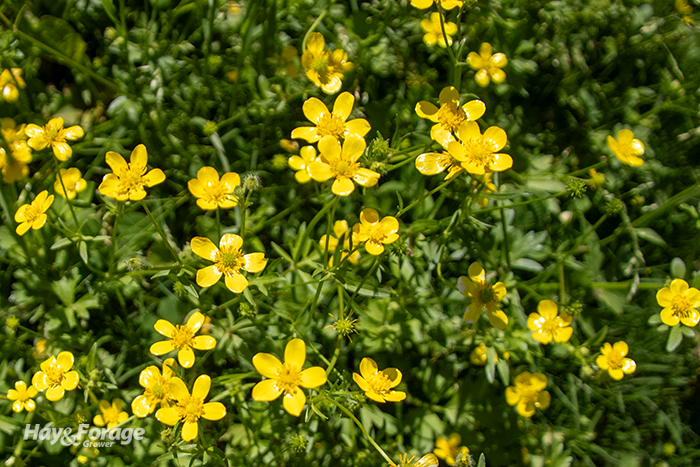
Unless you run a John Deere tractor or root for the Green Bay Packers, yellow and green don’t make the best color combination by most standards. It’s especially an eyesore in pastures and hayfields where buttercup quickly dominates, turning a sea of green into a carpet of yellow in a flash.
So far this spring, Victor Shelton has received more inquiries from Ohio farmers about buttercup than normal. The retired NRCS agronomist and grazing specialist purports the problem is due to the combination of overgrazing during last fall’s drought and the opportunity for buttercup to flourish on the now wet, compacted soil that was left bare.
Even though it seems like buttercup pops up out of the blue, Shelton explains that its seedbank develops over time. Seeds can lie dormant for three to five years before they germinate. “This is why buttercup seems to suddenly appear, even if it wasn’t noticeable in previous years,” he writes in an Ohio State University Extension article.
Buttercup takes advantage of open patches of pastures and hayfields where it can grow without competition from other species. Shelton says bare soil is like a blank canvas for buttercup, allowing it to grow quickly without competition from other forages.
Additionally, buttercup is a prolific seed producer, which amplifies its spread. A single plant can produce thousands of seeds, which can be dispersed by wind, water, livestock, and equipment. “The more competition from healthy, well-established forage, the less chance buttercup has to dominate,” Shelton states.
Nip it next year
Unfortunately, it’s likely too late to deter buttercup this year. Once its flowers rear their yellow heads, plants have already gone to seed and control tactics will be less effective.
For future reference, Shelton advises spraying buttercup before flowering early in the spring. However, there are few herbicides that offer sufficient control, and even fewer that won’t harm legumes like alfalfa and clover.
Rotational grazing practices that encourage more competition from desirable forages can also be effective. Shelton suggests shortening grazing periods, moving animals more frequently, and extending recovery time to arm pastures against weed pressure.
“While chemical control may offer short-term relief, long-term solutions focus on building a resilient pasture that can outcompete buttercup and other weeds,” Shelton states. “Ensure good soil fertility, promote diversity in your pasture mix, and utilize rotational grazing. Regular overseeding and maintenance of desirable forage species will keep the pasture thick and competitive.”
With that said, buttercup is toxic to all livestock species — especially horses. Although most animals find it unpalatable and tend to avoid it, Shelton says they may be forced to consume it if pastures are overgrazed and there are limited forage options. Buttercup can cause mouth blisters, diarrhea, colic, and in severe cases, death.
“Cattle may graze it in desperate conditions, and sheep are more likely to consume it when it's immature, though they can suffer from mouth blistering if they eat too much,” Shelton writes.
Make sure hay is clean and free of buttercup seeds, he adds. Otherwise, seed can spread when hay is fed on pasture or through livestock manure. Mowing pastures down after grazing is another measure to reduce seed production in early spring since plants can set seed low to the ground.
